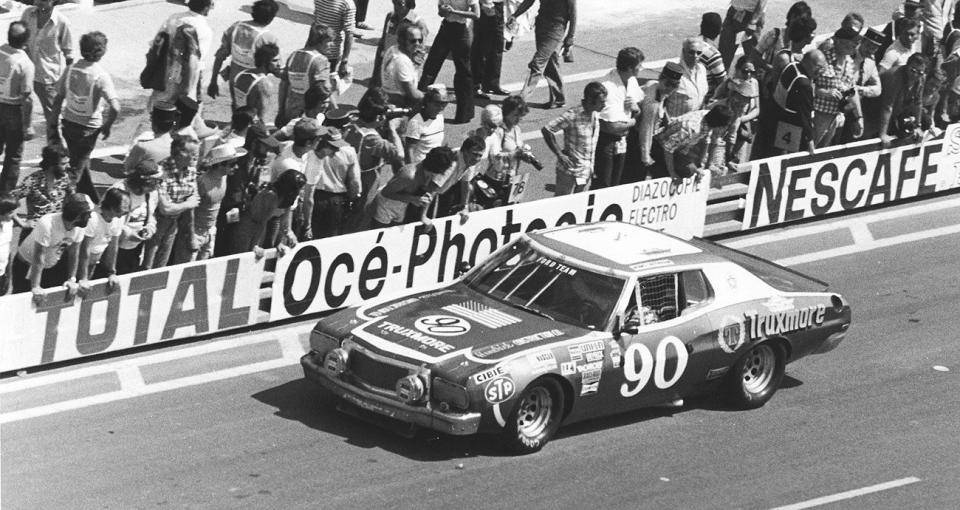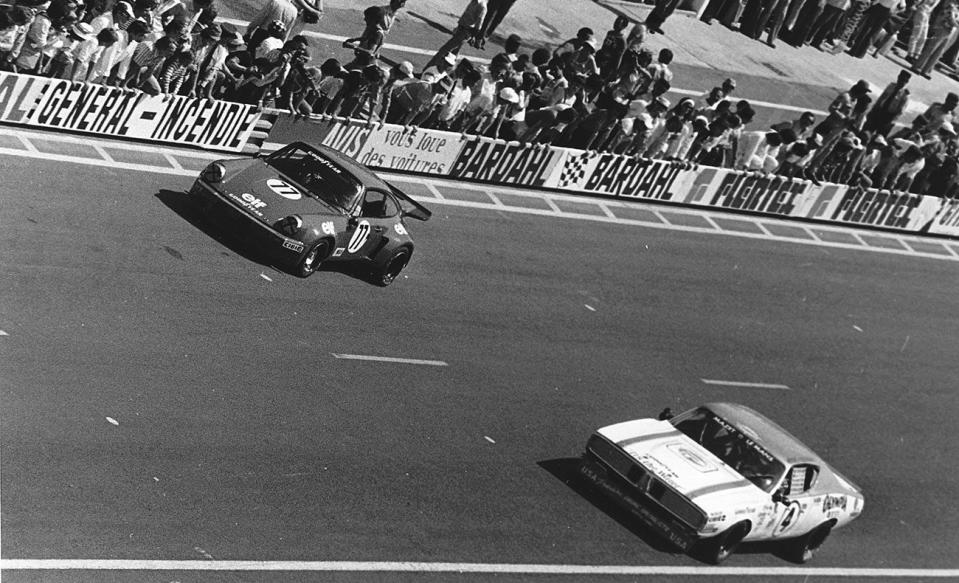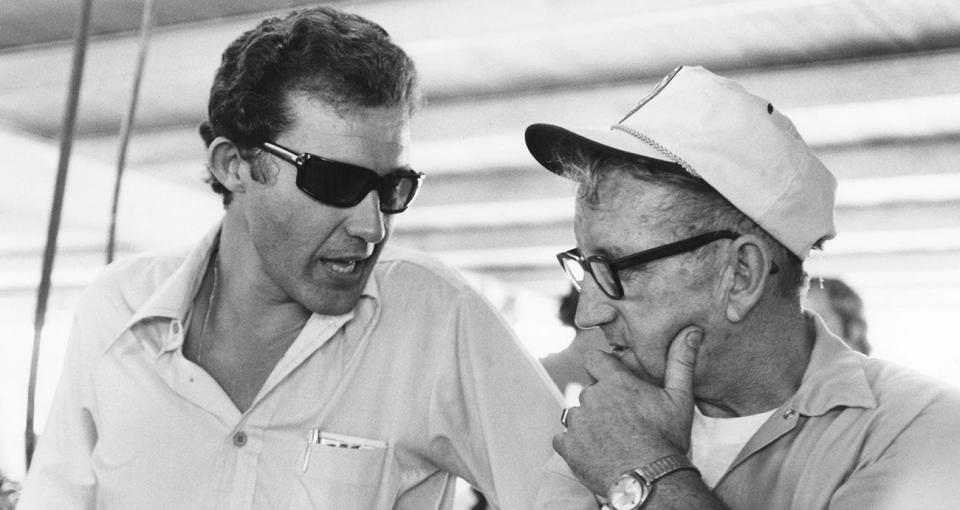Spirit of '76, legend of Junie Donlavey's 'Le Monster' car live on as Le Mans anniversary arrives
It was because Junie Donlavey didn‘t have the cash to send his NASCAR team west to Riverside, California, that Donlavey Racing instead ventured east across the Atlantic Ocean.
The trip was to the 24 Hours of Le Mans, where the No. 90 Ford Torino entered the world‘s biggest sports car event instead of a Cup race on June 13, 1976 at Riverside International Raceway.
If that seems quite the fanciful expedition, welcome to the life story of a charmed car owner who got by mostly on gumption and good cheer for more than 50 years in NASCAR.
“We didn‘t have money to get to Riverside, and we wound up in Le Mans,” Donlavey said with a laugh in a 2002 interview with the Richmond Times-Dispatch — the anecdotes and quotes from which mostly remained unpublished until this story. “That was a real experience.”

This weekend‘s running of the 24 Hours of Le Mans certainly will trigger memories of last year‘s Garage 56 project that put a Camaro ZL1 in the 2023 endurance racing classic. The joint effort between Hendrick Motorsports, NASCAR, Chevrolet and Goodyear was a smash hit, drawing an enthusiastic global fan reaction and spurring renewed manufacturer interest in Cup.
RELATED: At-track photos: Le Mans | Full recap of Garage 56‘s 24-hour run
With many getting their first glimpse of a Next Gen car, a crowd packed the city square where the Garage 56 Camaro went through pre-race inspection. Fans snapped photos and cheered for a megawatt lineup that included Le Mans winner Mike Rockenfeller, Formula One champion Jenson Button and seven-time Cup champion Jimmie Johnson.
NASCAR‘s first visit to the famed Circuit de la Sarthe nearly 30 years earlier was a more subdued affair for Donlavey‘s merry band of 15 (most of them volunteers) from Richmond, Virginia.
With Bill France engineering Le Mans entries for two stock cars, NASCAR financed overseas transport for the No. 4 Dodge Charger (driven by Hershel McGriff and his son Doug) and Donlavey‘s No. 90 Ford (driven by Americans Dick Brooks and Dick Hutcherson and Frenchman Marcel Mignot).
MORE: Full coverage of Garage 56 journey
“They took one car off the West Coast and one from (the East Coast),” Donlavey said. “NASCAR let me take a dozen crewmen over there and gave me a certain price for their tickets.”
But one of his volunteer team members also ran a travel agency and made the funding go much further.
“We took that money and broke it down, and we got 15 people over there for that amount,” Donlavey said. “We went to London for two days and two nights, Paris for two days and two nights and then Le Mans for eight or nine days. And my wife and four or five other ladies went.
“That one trip was all I wanted. It was worth it. We didn‘t have 10 cents and couldn‘t even get to Riverside. We still had a ball.”
• • •
Donlavey‘s car completed 104 laps before a gearbox failed roughly halfway through the 24-hour race. The McGriff car retired after two laps because its engine wasn‘t configured for the right octane.
But their V8 engines left an indelible mark with a roar unfamiliar to many European fans and media. Their celebrated response mirrored the spellbound reaction to the throaty rumble of last year‘s Camaro.
“We had headlines in the paper,” Donlavey said. “They called our cars, ‘The Le Monster.’ ”

His Le Mans outing is among many ways that the late team owner touched NASCAR despite a career with only one victory in 863 Cup starts from 1950-2002.
Sunday, June 9, marked 10 years since the passing of Donlavey (who would have been 100 in April), but his presence still is felt.
Next February, Ricky Rudd will be inducted into the NASCAR Hall of Fame in another reminder of Donlavey‘s impact on developing stars. Rudd ran the 1979 season for Donlavey, and the 22-year-old turned enough heads to help land a full-time ride at DiGard Racing.
MORE: 2025 Hall of Fame class revealed
“When he left us, he went straight on up,” Donlavey said of Rudd. “Kenny Schrader was the same way. One thing that puts fun in the game is if you have a rookie and watch him get better and better. That‘s the payoff more than the money you get.”
Schrader was the 1985 Cup Rookie of the Year with Donlavey Racing, which also won the award in 1980 with Jody Ridley (who gave the No. 90 its only win the next year at Dover) and in 1970 with Bill Dennis, who was the team‘s hometown star from Richmond. (With Dennis behind the wheel, Donlavey‘s team won three consecutive Permatex 300 season openers from 1972-74 at Daytona in Late Model Sportsman, the precursor to the Xfinity Series.)
Donlavey, belovedly nicknamed “Chief” by his loyal followers, provided up-and-coming opportunities for Brooks, Sonny Hutchins, Ernie Irvan and Robby Gordon. He also fielded cars for many NASCAR Hall of Famers, including Joe Weatherly, Bobby Isaac, Fred Lorenzen, David Pearson, Benny Parsons and Buck Baker.
But because he “wasn‘t used to country clubs, big bucks and all that stuff,” Donlavey operated his team as a feeder system rather than aspiring to become a powerhouse.
“To give someone a chance to get involved in this game, that meant more to me than worrying about winning a race,” Donlavey said. “I have everything that I needed. I came through the Depression years. We never knew it. Mama always had food on the table. What more did you want?
“So, to have an excess of a couple of million dollars in the bank, what good would it do if you don‘t use it?”
• • •
One of Donlavey‘s favorite stories of cultivating talent (while also scaring the daylights out of them) involved Gordon, whose NASCAR career began racing the No. 90 at Daytona and Richmond to start the 1991 season.
An off-road superstar weighing a career in IndyCar, Gordon tested at Daytona International Speedway for Donlavey and told the car owner during a break that he was unimpressed by the pace with restrictor plates on the 2.5-mile oval.
“He made the statement like, ‘These are nothing to drive right here, I could read a magazine coming down the backstretch,‘ ” Donlavey said. “We were changing carburetors, and I told them leave the (restrictor) plate off that thing. They said, ‘What?‘ I said, ‘Leave the plate off of it.‘
“Robby made two laps, and when he came in, his knuckles were white. Then he knew what those guys had gone through all those years running without a restrictor plate.”
Donlavey claimed NASCAR fined him $5,000. “Robby had the audacity the next day, he said, ‘Chief, we got another five grand we can stand to lose?‘ He wanted to try it again,” Donlavey said. “He made that lap running about 205 (mph). The fans watching that practice went nuts. He went through some of those turns sideways. Things like that make this game exciting and interesting.”

It always was more about the journey than the destination for Donlavey, who entered racing on a lark after returning from a stint in the Navy (he was in Guam when World War II ended) and going into the auto repair business with his father in 1946.
In a 2014 tribute, longtime NASCAR journalist Monte Dutton wrote that in a sport of “saints and sinners, workaholics and con artists, contenders and pretenders,” Donlavey was “the only leprechaun. I will never think of the No. 90 without thinking of the leprechaun Junie Donlavey, always chuckling, never depressed or angry, everything in its proper perspective.”
That‘s another way that the Le Mans experience was a fitting encapsulation of the life and times of Donlavey, who seemed as enamored with the places he visited as the famous tracks he raced.
“When you‘re in a race, if you don‘t win, it‘s not the end of the day,” he said. “You still had fun participating. If you got into racing and the only thing that satisfied you was winning, your life would have so many hills and valleys in it.
“There‘s only one thing I enjoy more than racing and that‘s being around the people. You wouldn‘t believe the number of nice people all over the country you meet. The only thing I regret is it passed by so quickly.”
Nate Ryan has written about NASCAR since 1996 while working at the San Bernardino Sun, Richmond Times-Dispatch (where he covered Junie Donlavey‘s final years in NASCAR), USA TODAY and for the past 10 years at NBC Sports Digital. He is the host of the NASCAR on NBC Podcast and also has covered various other motorsports, including the IndyCar and IMSA series.

 Yahoo Sports
Yahoo Sports 
